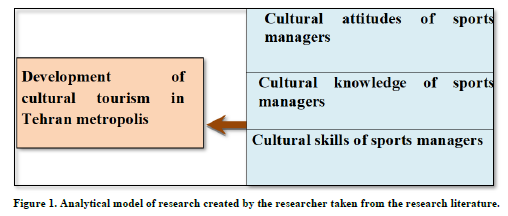478
Views & Citations10
Likes & Shares
In many countries, the tourism industry is an expression of the cultural identity of a country and one of the important sources of income for that country. The development of this industry is of particular importance for developing countries that are facing problems such as unemployment, limited foreign exchange resources, and monoculture economy. Based on the discourse approach, tourism facilitates interactions between cultures and establishes cultural patterns needed for development through intercultural communication (Jalilian et al., 2016).
The ability of the host country to accept tourists with different cultural backgrounds and to provide services to tourists of various religions, languages, customs and interests. It requires the creation of an appropriate cultural platform and the existence of trained manpower in different service departments (Nasserpour, 2016).
On the other hand, the study of studies carried out in Iran in order to design an optimal administrative system, mostly revolves around factors such as human resource management, structure, processes, procedures, laws and regulations, administrative and service culture, information technology, evaluation and monitoring, and organizational culture. The issue of the culture of the Iranian society has been less addressed, while especially in multicultural and ethnically diverse countries like Iran, without a doubt, paying attention to the culture and possessing the cultural competence of managers is one of the important factors of their success and high productivity in different geographical areas, which has been neglected. taken and not addressed. Research has shown that since the emergence and development of the human race, there have always been leaders in different societies who have guided others so that everything works properly and stays in order. As a result, managers should be able to be effective on their employees (Crespo et al., 2021). Accordingly, one of the important challenges of today's organizations is the analysis of managers' behavior (Agourieh et al., 2017). Reviewing the process and the historical background of evolution and transformation of different eras shows that in different eras, the tools and sources of power of governments and nations were different, and today, the value and wealth of nations, governments, and organizations will be based on the knowledge, skills, and competence of their members. The knowledge, insight and skills of people in society are the product of educational systems in a complex and time-consuming process. In the meantime, societies and organizations will be in charge of affairs that have designed and managed such an educational system with a timely transactional approach and with strategic thinking. The product of such a process will be competent people who will play a significant role in planning the future and achieving the goal of excellence (Ashighi et al., 2016).
In societies like Iran, with different racial, ethnic and religious groups (Shia &Sunni), access to preventive measures to overcome the effects of racial and religious discrimination and inter-group conflicts in the organization is very important. Behaviors based on the understanding of differences are, in most cases, an incompatible behavior that can harm the society and relationships between people, and among its reasons can be mentioned the frustration and strengthening of behavior related to prejudice, which due to the socio-cultural situation in Iran, stereotypes caused by Prejudice abounds.
For this reason, it is important that managers of organizations have (Banab, 2020). cultural competence to manage these issues. Cultural competence is defined as the recognition and responsiveness of organizations to the service needs of culturally, linguistically diverse populations and innovation in support services, which refers to the need to invest in administrative components, policies and service delivery to improve quality (Jarro & Kim, 2013).
A large part of the obstacles to the development of cultural tourism in the world are cultural issues. When a person wants to travel, the culture of the host society is very important and significant. In cultural tourism, culturally necessary considerations regarding the needs of tourists who have entered the country with the aim of improving their health and well-being should be observed. Social, cultural and political issues can affect the choice of cultural tourists and even change their destination (Jalilian et al., 2016).
According to the above, in this research, the effect of cultural attitude, cultural knowledge and cultural skills of sports managers in the development of cultural tourism in Tehran metropolis has been investigated.
Theoretical foundations and conceptual model of research
One of the common points of human societies throughout the ages is culture, in fact, culture forms an important part of people's lives. Culture, in the form of structures in which people are born, nurtured and experienced, such as race, nationality, gender, class or religion, language, etc., gives a person a certain worldview. Views, values, beliefs and convictions, humor, hopes and dreams, loyalty, worry, fear, etc. are cultural components that basically shape people's behavior under their influence. Culture is a combination of what we inherit and what we learn throughout life (Song, 2019). Increasing the cultural competence of employees and managers throughout the organization is very important to increase behavioral justice. In addition, adopting and integrating culturally responsive policies and practices provides many benefits not only to the customer, but also to the organization and its employees. Most importantly, it increases the probability of sustainability and survival of the organization. Organizational investment in upgrading cultural competences and increasing culturally responsive services will probably increase the use and cost-effectiveness of the organization's material and spiritual resources and facilities. A key principle in culturally responsive practices is the interaction of society, customers and employees, and by increasing attention to cultural competence, more organizational trust and customer and employee satisfaction can be increased. Formulating organizational policies appropriate to cultural competence, including recruitment and executive operations, is essential in 21st century organizations (Pola et al., 2012). Also, not paying attention to culture weakens the profitability and sustainability of the organization.
CULTURAL COMPETENCE
Cultural competence is a complex and multidimensional concept that has been studied in many disciplines and has been assigned to many workshops at the level of universities around the world (Farber, 2019: 84). Since the definition of cultural competence is the process of acquiring the ability of cultural attitude, cultural knowledge and cultural skills for effective interaction and caring for people who have different cultural backgrounds, the concept of cultural competence includes the process of acquiring and developing attitudes, knowledge and skills (Khaderlo & Mokhtari, 1394). The formation of cultural competence requires the education and development of legal and ethical norms at least at the level of bachelor's and master's education (Zerzika et al., 2020).
Cultural attitude
Cultural attitude is the first stage of acquiring cultural competence. This attitude is the way people think about culture and people who are from different cultures, especially an attitude shows how people behave. Cultural awareness needs people who are sensitive to the values, beliefs, performance and way of life according to the culture of the clients. It is necessary for employees to be sensitive to the surrounding environment and to have the highest priority. Therefore, it is important for them to pay attention to the fact that they are interacting with people from different cultural backgrounds. Employees must be able to understand the differences of customers through their different senses such as hearing, seeing, smelling and touching, and after this stage, the received information is processed. Since the way of thinking and the type of behavior of people is based on the type of view and worldview and their cultural background, therefore their attitude is also different in different cultures. Therefore, this process should include evaluating one's view about other cultures and analyzing their values, beliefs and practices. A person's self-awareness towards his attitude is necessary. In addition, people who have a positive cultural attitude accept people from other cultures better and show more willingness to learn about other cultures than people who have a negative attitude (Komas et al., 2007).
Cultural knowledge
Cultural knowledge helps people to reach a higher level of understanding in relation to cultural differences. This information helps people with a negative attitude to adapt sooner, it can even change people's negative attitude. Nevertheless, it seems necessary for people to acquire intercultural job knowledge. For example, intercultural nursing means providing physical, mental and spiritual nursing, while the cultural beliefs and behaviors of clients are considered to have cultural diversity. In other words, intercultural nursing refers to the values, beliefs and exemplary ways of living that are objectively and subjectively learned and transferred and by helping, supporting and empowering the individual and the group, they maintain health and improve the lifestyle. and coping with illness, disability and death (Khaderlo & Mokhtari, 2014).
Cultural skill
Among these three sub-concepts, the concept of cultural skill in acquiring cultural competence is more complicated than the previous two concepts. Many people have both a good cultural attitude and sufficient cultural knowledge; However, they are still not competent in terms of cultural skills. Sometimes, employees may not know the correct way to use this knowledge in practice, or they may refuse to use it in practice for various reasons (Khezrlu & Mokhtari, 2014). Employees who have cultural skills not only have the ability to work with people from different cultural backgrounds, but they can also communicate with those who are different in terms of gender, age, education, faith, sexual orientation, socioeconomic status, and ability level establish.
Acquiring skills requires specific cultural knowledge and training. Therefore, when employees start interacting with customers from different cultural backgrounds, it is necessary to use their cultural knowledge and attitude to assess the cultural needs of customers. This stage is also very useful because cultural skill is about learning how to determine the values, convictions and beliefs of a client through his cultural evaluation (Khezrlu & Mokhtari, 2014).
Cultural tourism
Today, tourism is the third largest industry in the world after oil and automobiles.
This industry is important not only for earning money, but also for the development of culture and communication. Based on the practical plan for the development of tourism culture, special attention should be paid to sustainable criteria; This means that long- term ecological issues, financial issues and necessary obligations regarding social and moral aspects should be observed. Also, the nature of sustainable tourism requires the sustainability of natural, cultural and human environments. Tourism should consider cultural aspects, values and traditional elements of local communities. On the other hand, paying attention to tourism is one of the ways to achieve sustainable development. The sustainable development of tourism has two aspects of protecting the environment and resources and the cultural heritage of communities. Therefore, sustainable tourism must be implemented with a specific and codified policy in order to guarantee a promising movement in the all-round development of geographical spaces (Azeimi, 2016).
Cultural tourism at the local and native level shares and overlaps with heritage tourism and cannot be defined as two completely independent and separate types. Therefore, expressing the phrase “heritage cultural tourism” is a great help to bring together all the stakeholders who need to cooperate in this category, including organizations and providers of arts, museum organizers, those involved in humanitarian issues and historical preservation, heritage sites, ethnic groups and It also becomes a participant in tourism programs and includes things such as historical and ancient places, places of war and conflict, cities, central markets, suburbs, historical buildings, heritage monuments, paths and waterways. It refers to heritage structures, heritage handicrafts and related products. (Jalilian et al., 2016:37).
RESEARCH MODEL
Independent variable: cultural attitude of sports managers, cultural knowledge of sports managers, cultural skill of sports managers.
Dependent variable: development of cultural tourism in Tehran metropolis (Figure 1).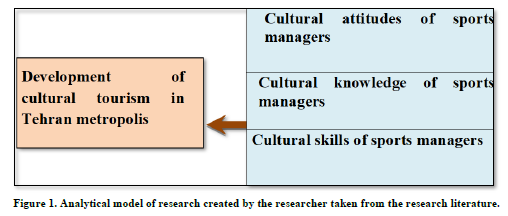
Research hypotheses
The main hypothesis
The cultural attitude of sports managers, the cultural knowledge of sports managers, and the cultural skills of sports managers are effective in the development of cultural tourism in Tehran.
Sub-hypotheses
- The cultural attitude of sports managers is effective in the development of cultural tourism in Tehran.
- The cultural knowledge of sports managers is effective in the development of cultural tourism in
- The cultural skill of sports managers is effective in the development of cultural tourism in
Research method
The current research is of an applied type because the purpose of this research is to develop practical knowledge in a specific field, with the intention of using the results of the findings to develop reliability. Also, in the field of data collection, the present study is a descriptive study of the survey type. The statistical population in this research is all the sports managers in the metropolis of Tehran. which are about 5000 people.
According to the sampling criteria (based on the sampling method listed in Morgan's table), 384 people have been selected as the research sample from the mentioned statistical population. In this study, in order to analyze the data, two general statistical approaches, descriptive statistics and inferential statistics, were used. Descriptive statistics were used to describe the demographic characteristics of the statistical population in addition to measuring data dispersion indices. Also, inferential statistics and the application of Spearman's non-parametric correlation test were used to investigate the significance of the assumed effect of the variables on each other. The current study includes a main hypothesis and 3 sub-hypotheses.
Research findings
Testing research hypotheses
In this section, according to the obtained data and using statistical tests, the research questions are tested.
First, the assumption of normality of the statistical population has been tested using the Kolmogorov-Smirnov test. The results of this test are shown in the Table 1 below.
Zero assumption: the distribution of research indicators is normal Assumption one: The explanation of research indicators is not normal.
Considering that the significance levels obtained in Table 1 for this test are more than the considered level of 5%, therefore there is no reason to reject the null hypothesis, which means that the distribution of the research indicators is normal.
Considering the normality of the distribution of the research indicators, Pearson's correlation coefficient parametric tests and regression models are used to investigate the research hypotheses.
In this section, according to the data obtained from the sample and using statistical tests, the research hypotheses are tested.
Pearson's correlation test has been used to check the intensity of the relationship from regression analysis to check the research hypotheses, which is related to the investigation of the significant relationship between the research variables.
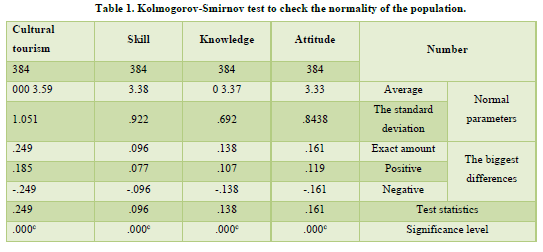
Hypothesis 1: The cultural attitude of sports managers has a significant impact on the development of cultural tourism in Tehran.
Pearson's correlation test is used to test this hypothesis. The hypothesis is defined as follows:
Hypothesis zero: the cultural attitude of sports managers does not have a significant effect on the development of cultural tourism in the metropolis of Tehran.
Hypothesis one: the cultural attitude of sports managers has a significant impact on the development of cultural tourism in Tehran.
According to Table 2 the Pearson correlation coefficient obtained between the cultural attitude of sports managers and the development of cultural tourism in Tehran metropolis is 0.355, and the obtained significance level of 0.000 is smaller than the considered error level of 0.05, so the null hypothesis is rejected. And hypothesis one, based on the fact that the cultural attitude of sports managers has a significant impact on the development of cultural tourism in Tehran metropolis, is accepted.
From the result of this hypothesis that a positive and significant correlation coefficient was obtained, it is inferred that there is a direct and significant relationship between the cultural attitude of sports managers and the development of cultural tourism in the metropolis of Tehran, so that with the increase of one variable, the other variable will also have an upward trend.

The result of hypothesis 1 showed that the correlation coefficient between the cultural attitude of sports managers and the development of cultural tourism in the metropolis of Tehran was found to be positive and significant, now to check that the variable of cultural attitude of sports managers is a predictor of the development of cultural tourism in the metropolis Regression is used. In this test, the statistical hypothesis was expressed as follows:
A positive and significant value was obtained in Tehran metropolis, now regression is used to check that the variable of cultural attitude of sports managers is a predictor variable of cultural tourism development in Tehran metropolis. In this test, the statistical hypothesis was expressed as follows:

In the test of the above hypothesis, the first assumption is that the regression coefficients of the variable of cultural attitude of sports managers and the development of cultural tourism in the metropolis of Tehran are significant, and the null hypothesis is that the regression coefficients are not significant:
According to Table 3 (significance levels obtained for the regression coefficients are less than the error level of 0.05 and this means that the regression coefficients are significant) the following regression model is obtained:

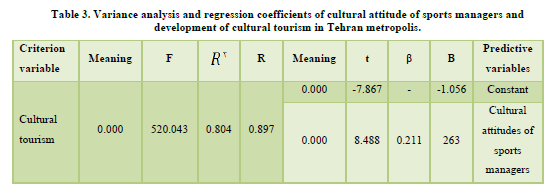
Hypothesis 2: The cultural knowledge of sports managers has a significant impact on the development of cultural tourism in Tehran
Pearson's correlation test is used to test this hypothesis. The hypothesis is defined as follows:
Hypothesis zero: the cultural knowledge of sports managers does not have a significant effect on the development of cultural tourism in the metropolis of Tehran.
Hypothesis one: The cultural knowledge of sports managers has a significant impact on the development of cultural tourism in Tehran.
According to Table 4, the Pearson correlation coefficient obtained between the cultural knowledge of sports managers and the development of cultural tourism in the metropolis of Tehran is 0.752, and the obtained significance level of 0.000 is smaller than the considered error level of 0.05, so the null hypothesis is rejected. And hypothesis one, based on the fact that the cultural knowledge of sports managers has a significant impact on the development of cultural tourism in Tehran, is accepted.
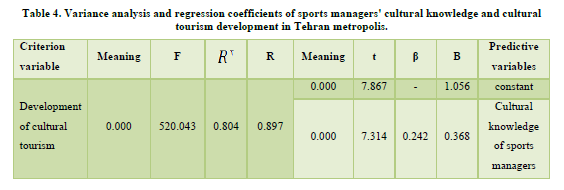
From the result of this hypothesis that a positive and significant correlation coefficient was obtained, it is inferred that there is a direct and significant relationship between the cultural knowledge of sports managers and the development of cultural tourism in the metropolis of Tehran, so that with the increase of one variable, the other variable also has an upward trend Will have.
The result of hypothesis 2 showed that the correlation coefficient between the cultural knowledge of sports managers and the development of cultural tourism in the metropolis of Tehran was found to be positive and significant. Regression is used. In this test, the statistical hypothesis was expressed as follows:
In the test of the above hypothesis, hypothesis one is based on the fact that the regression coefficients of the variable of cultural knowledge of sports managers and the development of cultural tourism in the metropolis of Tehran are significant, and on the other hand, the null hypothesis is that the regression coefficients are not significant:
According to Table 4 (significance levels obtained for the regression coefficients are less than the error level of 0.05 and this means that the regression coefficients are significant) the following regression model is obtained:
In the above regression equation, the dependent variable of cultural tourism development in Tehran metropolis, the predictor variable is the cultural knowledge of sports managers and the error rate of the model.
Hypothesis 3: The cultural skill of sports managers has a significant impact on the development of cultural tourism in Tehran.
Pearson's correlation test is used to test this hypothesis. The hypothesis is defined as follows:
Hypothesis zero: the cultural skill of sports managers does not have a significant effect on the development of cultural tourism in the metropolis of Tehran.
Hypothesis one: the cultural skill of sports managers has a significant impact on the development of cultural tourism in Tehran.
According to Table 5, the Pearson correlation coefficient obtained between the cultural skills of sports managers in the development of cultural tourism in Tehran metropolis is 0.834, also the obtained significance level of 0.000 is smaller than the considered error level of 0.05, so the null hypothesis is rejected. And the assumption that the cultural skill of sports managers has a significant impact on the development of cultural tourism in Tehran metropolis is accepted.
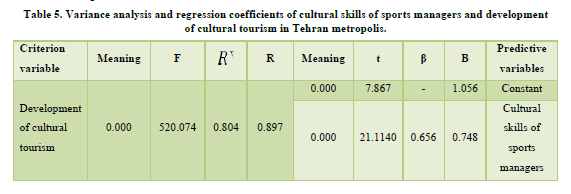
From the result of this hypothesis that a positive and significant correlation coefficient was obtained, it can be inferred that there is a direct and significant relationship between the cultural skills of sports managers and the development of cultural tourism in the metropolis of Tehran, so that with the increase of one variable, the other variable will also have an upward trend.
The result of hypothesis 3 showed that the correlation coefficient between the cultural skill of sports managers and the development of cultural tourism in the metropolis of Tehran was found to be positive and significant. Regression is used. In this test, the statistical hypothesis was expressed as follows:
In the test of the above hypothesis, the first assumption is that the regression coefficients of the cultural skill variable of sports managers and the development of cultural tourism in Tehran metropolis are significant, and the null hypothesis is that the regression coefficients are not significant:
According to Table 5 (significance levels obtained for the regression coefficients are less than the error level of 0.05 and this means that the regression coefficients are significant) the following regression model is obtained:
In the above regression equation, the dependent variable of the development of cultural tourism in the metropolis of Tehran is the predictor variable of the cultural skill of sports managers and the error rate of the model.
In the above regression "y" equation, the dependent variable of the development of cultural tourism in the metropolis of Tehran is the predictor variable of the cultural skill of sports managers and "ei" the error rate of the model.
CONCLUSION
Cultural issues are considered one of the fundamental concepts in modern sociology and today's fast-paced and transforming world, in such a way that it has been one of the most basic theoretical topics in social sciences in the past until today, and since the 1980s, culture has become the main concern of management. It started when Japanese companies outperformed American companies and Japanese culture or Japanese management was used as the secret recipe for their success, but managers can never change the national culture, they can only understand it and learn from it. use (Hofstede, 2011).
Humans have many needs, one of which is the need for travel and tourism.
Traveling is one of the main aspects of the emergence of civilization and the most important factor in the exchange of cultures of nations and the discovery of new lands. Also, the tourism industry is one of the most profitable industries in the world. An industry that has the highest efficiency for the lowest cost and is expected to become a competitor of other powerful industries in the world in the next few years. Iran is a rich country in terms of historical attractions, the existence of beautiful and pristine areas, historical attractions and Its ancient civilization has the ability to attract millions of tourists. Amazing tourism attractions include ancient attractions such as Takht Jamshid, Biston, the cities of Isfahan, Shiraz, Shahr Sokhte, Zabul, Kashan and natural attractions such as: the north of the country and even the beautiful central deserts are among the country's tourism attractions. The tourism industry in Iran, especially cultural tourism, has many problems, the most important of which is the lack of facilities and provision for cultural tourists, such as: passport and visa obstacles, administrative problems, and the lack of facilities for the entry and exit of nationals. foreign. Despite its ancient civilization and historical attractions, Iran has a half-life and sick cultural tourism industry. In general, there is no national view of this industry and its share of this lucrative industry is not even comparable with the countries of the region. Considering that this industry is considered as the biggest employer in many countries, but it has not developed much in Iran and even the human forces that are engaged in this industry are very small. In terms of religion, Iran is one of the top ten countries in the world in terms of historical buildings.
It should be done by providing a platform to attract and attract tourists from the world by creating a variety of standard services, sufficient education in the field of tourism, preparation of guide maps and necessary advertising brochures in order to inform tourists and the necessary information that satisfies the needs of a tourist.
- Angelkova, T. (2012) Sustainability and competitiveness of tourism. Procardia Social and Behavior Sciences, 44, 221-227.
- Aguirre León, G., Serrano Orellana, B., & Sotomayor Pereira, G. (2017). The leadership of the managers of the SMEs of Machala. University and Society Magazine, 9, 187-195.
- Crespo, M. D. V., Betancourt, L. A. A., Joniaux, C. A. M., & Monier, Y. P. R. (2021). Evaluation of the impact of leadership competence in the administrative management of the banking system in Manta Ecuador. International Journal of Economic Perspectives, 15, 162-177.
- Farber, J. E. (2019). Cultural Competence of Baccalaureate Nurse Faculty Relationship to Cultural Experiences. Journal of Professional Nursing, 35, 81-88.
- Faruzandeh, A. (2016). Intercultural communication in tourism: tourism culture, prerequisite for economic development. Transportation Industry Monthly, 306, 81-78
- Hofstede, G. (2011), National cultures organizational cultures and the role of management Values and Ethics for the 21st Century. Madrid.
- Hassan,A., Mohammad,G., Nadergholi,G. (2016). Development of a conceptual model for the design of managers' training programs based on managerial competence: A qualitative research. Educational Management Innovations, 12, 61-47
- Jirwe M, Gerrish K, Keeney S, Emami A. (2013). Identifying the core components of cultural competence: finding from a Delphi study. Journal of Clinical Nursing, 18, 2622-34.
- Khizrloo, Samiya, Jamila, M. (2014). Cultural competence in nursing education: a review article Iranian Journal of Medical Ethics and History, 8, 11- 21.
- Kumas Tan Z, Beagan b, Loppie C, Macleod A, Frank B. (2007). Measures of cultural competence: Examining hidden assumption. Academic Medicine, 82, 548-57.
- Laiya, J., Chaghajerdi, I., Fatuhi, Z., Prafiri Goharrizi, S. (2016). Analysis of cultural tourism development strategies of Isfahan using SWOT QSPM model, Journal of Cultural Management, 39.
- Mehrdad,N. (2016), study of the effect of non-medical factors on the development of health tourism, master's thesis, department of business management marketing orientation Lorestan University Faculty of Economics and Administration.
- Mohammad, S., Showkat Ahmad, G., Imran, S. (2019). Employee Competencies as Predictors of Organizational
- Performance A Study of Public and Private Sector Banks. Management and Labour Studies, 1-7.
- Pulla, V., Chenoweth, L., Francis, A., & Bakaj, S. (2012). Papers in strengths-based practice, 322.
- Song, J. (2019), Essentials for Developing Cultural Competence in Occupational Therapy the Cultural Competence Workshop for Occupational Therapy Practitioners Ph.D. thesis.
- Sharbatian, Hassan, M. (1390). A reflection on the development of urban tourism in Iran and providing the necessary solutions for it.
- Taqi Dizj,S., Shujaei,A., Atiyeh., & Najad, M. (2015). Investigating the role of urban tourism in economic growth and development of cities. First International Conference on Urban Economics, pp: 601-607.
- Zarzycka, D., Chrzan Rodak, A., Bak, J., Niedorys-Karczmarczyk, B., & Slusarska, B. (2020). Nurse Cultural Competence cultural adaptation and validation of the Polish version of the Nurse Cultural Competence Scale and preliminary research results, PLoS One, pp: 15.

